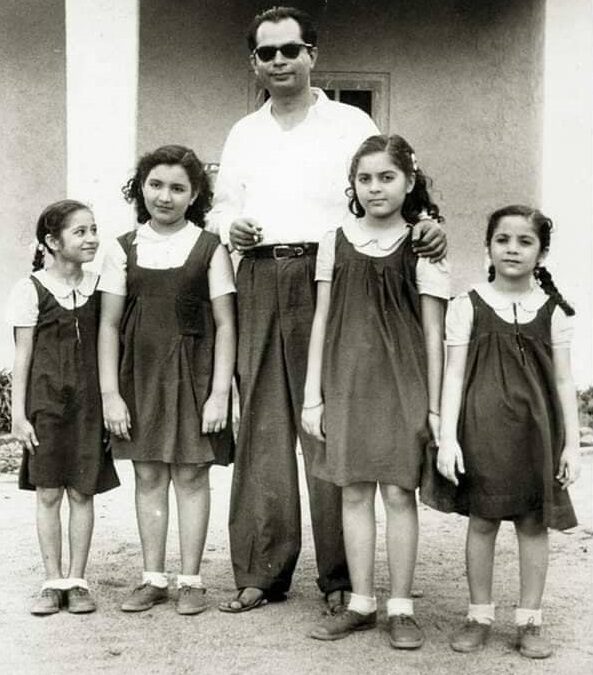I seriously doubt if anyone has heard of a film called Baap Beti, one of the invisible pieces in Bimal Roy’s enduring film library. The film went into production between 1953/4 but struggled precariously for existence for years. Baap Beti started with a big muhuraat at the obscure M&T studio. I remember the elderly Vijay Bhatt (director of Baiju Bawra) sounding the clap for Baap Beti. The M&T studios was virtually owned and patronized by director Bhatt. The studio however was a poor relation to the thriving Mohan studios on the Kurla Road, east of Andheri. It did not boast of the glamour or the hustle and bustle connected with film productions. Indeed M&T no longer exists.
Apparently, film producers superstitiously believed in muhuraats. A film muhuraat was a must whether the film got made or not.
Baap Beti by the way was inspired by a French film called, Simon’s Papa. My mother had fallen hopelessly in love with the film. Quite often I heard my parents discuss stories and their cinematic possibilities. One breakfast, I overheard my mother saying that Simon’s Papa was a bittersweet tale of a fatherless child going through the trauma of an absent father syndrome. She was convinced it was a suitable saga. Thus making a strong case for an Indian version of Simon’s Papa. The French film was put on hold for a likely production -like several other stories my parents liked.
Meanwhile, I clearly remember seeing a tall dhoti clad man hovering around baba, almost shadow him. With folded hands he requested my father to direct a film that he hoped to produce. The man – one Munshiji, was the striking image of a polite, God fearing man one rarely saw in the Bombay film industry.
Fly by night characters from small towns frequently came with similar requests to father. All of them had one common dream- to be rich and famous overnight in the formidable bastion of the Indian moviedom. Most of them perished by the way but Munshiji managed to survive. At the time Baba was busy directing two films, Parineeta and Do Bigha Zamin. He had no time to consider another project, or consult with Munshiji , the serious Bimal Roy bhakt. Cleverly, Baba turned Munshiji over to his screenplay writer, Nabendu Ghosh. Incidentally Nabendu Ghosh too sported a dhoti kurta. But the similarity ends there.
Out of pure sympathy, I imagine, baba managed to squeeze one or two scenes of Baap Beti at Bombay Talkies where he was shooting Ashoke Kumar production’s Parineeta . The scenes featured school girls with lead protagonist – Baby Tabassum, arguably the most popular child actor of her time. The Baap Beti film set had cute wooden chairs and tables suited for a class room. Little did I suspect that one day these would become permanent furniture in homes we visited, for example, the house of Baba’s senior assistant Asit Sen- (who doubled as a comedian). The shooting of Baap Beti went on erratically as Munshiji ran short of funds. He could not pay the technicians nor arrange the money. Then he vanished. Frustrated by the unhappy turn of events baba asked his unpaid assistants to take home props from the Baap Beti set. Little school chairs and tables adorned the homes of Baba’s DOP and chief AD.
I remember very little except one or two moving scenes. Yet the film is quite exceptional in many ways. Not only was the main protagonist a school girl, she was raised by a single mother played by an old timer, actress Madhuri. Uncommon to find a single mother – daughter relationship in Hindi cinema’s history. The star cast too was unconventional. Tamil super star Ranjan, popular as India’s Douglas Fairbanks, played the man, the pretend father of the girl. Baap beti was Ranjan’s Hindi debut.
In Bombay’s stubborn star system, imagine a school girl heroine, no romancing around trees, item numbers, leery villains, and a single mother? The film however was doomed from the start despite a challenging and modern theme. It was long before its time, I daresay. We have lost that charming film, not a frame exists. All we have is a haunting Lata lullaby by composer Roshan.
It was therefore incredible to find a quaint photo of my father posing with Baap Beti child stars discovered on F.B or insta . Several friends sent it, thinking I was one of those girls! I was flooded with sweet memories of Baba who shared a special rapport with children – indeed he was adored by his child stars, whether it was Baap Beti, Sujata or Do Bigha Zamin for that matter. Thankfully no child actor in a Bimal Roy film mouthed heavy, meaningful dialogues – on the contrary, they behaved with spontaneity and were refreshingly natural.
Regrettably we cannot watch Baap Beti . How I wish we could .
Rinki Roy Bhattacharya
Chairperson: Bimal Roy Memorial Committee
102 Spencer Society, New Kantwadi Road,
Bandra-West, Mumbai- 400050
Maharashtra, India.
bimalroymemorial@gmail.com


